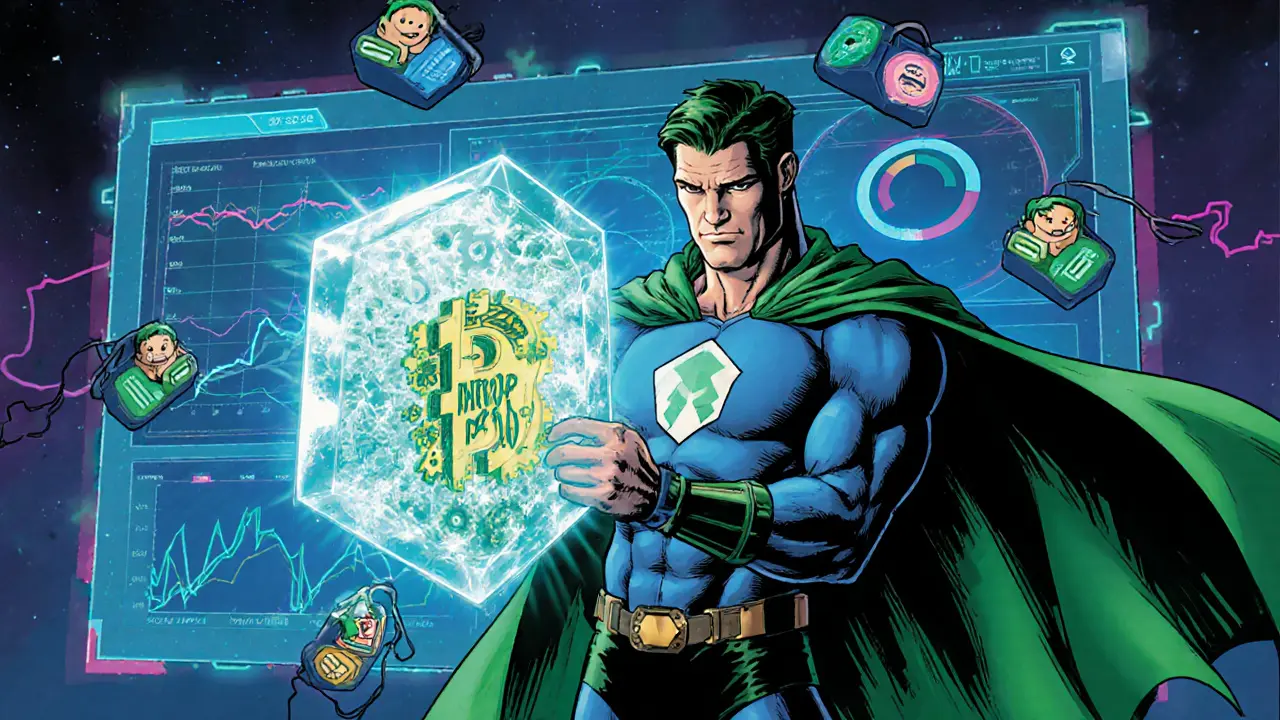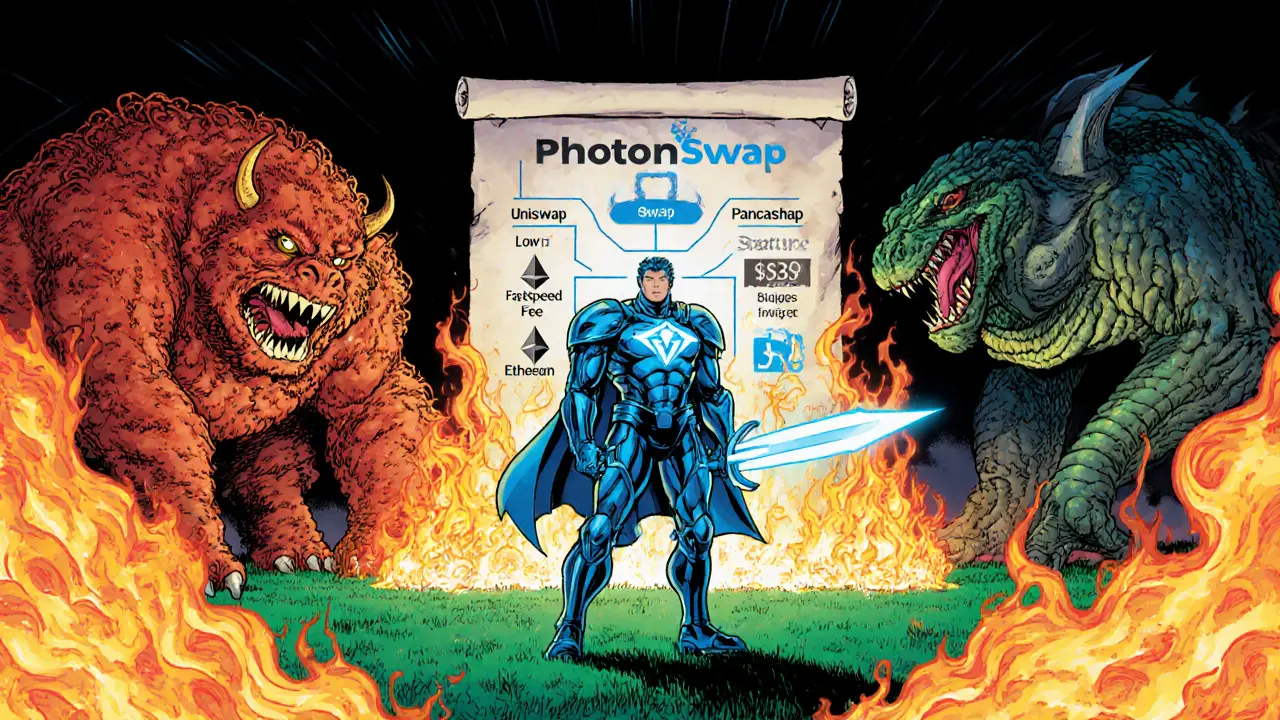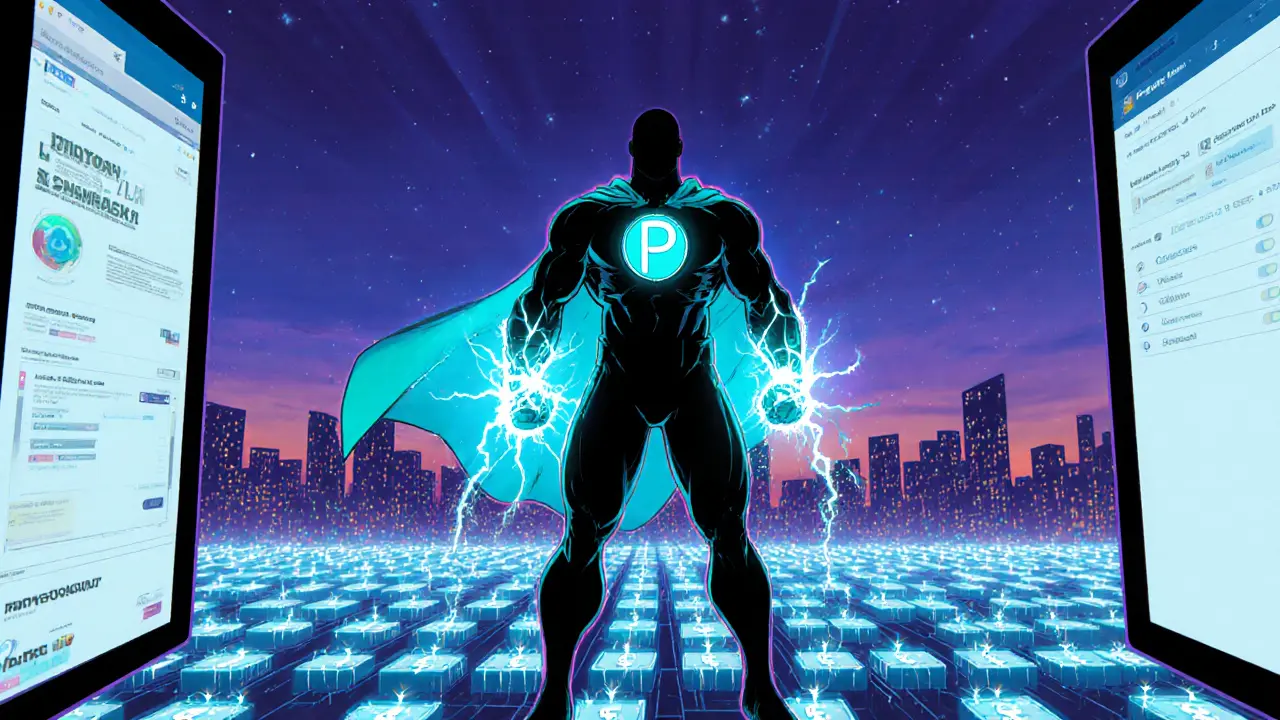PhotonSwap Fee Calculator
Savings Analysis
Based on your inputs, here's how PhotonSwap compares to other DEXs:
Potential Monthly Savings:
PhotonSwap vs. Uniswap: $0.00
PhotonSwap vs. PancakeSwap: $0.00
PhotonSwap.finance is a decentralized exchange (DEX) built on the Cronos blockchain. It lets anyone trade ERC‑20‑style tokens, stake the native PHOTON token, and view on‑chain analytics - all from a web‑based UI. If you’re scanning the market for a low‑fee DEX that caters to Cronos users, this review tells you what to expect, where it shines, and where it falls short.
TL;DR
- PhotonSwap runs on Cronos, offering fast, cheap swaps and native staking.
- PHOTON token provides governance, fee discounts, and staking rewards.
- Interface is clean but documentation is thin; beginners need some wallet setup knowledge.
- Compared to Uniswap and PancakeSwap, PhotonSwap has lower fees but less liquidity and fewer third‑party integrations.
- Future updates (v1.0.41+) focus on deeper analytics and cross‑chain bridges.
What is PhotonSwap?
PhotonSwap is a DEX that lives on the Cronos blockchain. Cronos is a Cosmos‑based layer‑1 that aims to combine Ethereum‑compatible smart contracts with the low‑cost, high‑throughput environment of the Cosmos ecosystem. By building on Cronos, PhotonSwap can process trades in seconds and keep gas fees in the range of a few cents - a stark contrast to the $10‑$30 fees that sometimes hit Ethereum‑based swaps.
How It Works - Connecting Your Wallet
To start trading, you need a Web3‑compatible wallet (MetaMask, Trust Wallet, or Crypto.com DeFi Wallet are the most common). The platform uses standard Web3 connection prompts, so when you click “Connect Wallet” you’ll see the familiar popup asking you to approve the connection. After approval, your wallet address appears in the top‑right corner, and you can instantly access the Trade, Stake, and Analytics tabs.
Core Features
- Trade: Swap any ERC‑20 token on Cronos with a simple two‑field form. The UI shows real‑time price, slippage tolerance, and transaction fee.
- Stake: Lock PHOTON tokens in the platform’s staking contracts to earn a share of swap fees and additional token rewards.
- Analytics: On‑chain dashboards display volume, liquidity, and price charts for each pair, borrowing data from CoinGecko and the platform’s own indexer.
- Bridges: Built‑in cross‑chain bridges let you move assets between Cronos and Ethereum, Binance Smart Chain, or Polygon without leaving the DEX.
- Links: Quick access to community channels (Telegram, Discord) and the PHOTON token’s official page.
PHOTON Token - The Heartbeat of the Platform
The native PHOTON token serves three purposes:
- Governance: Holders can vote on protocol upgrades via on‑chain proposals.
- Fee Discounts: Staking PHOTON reduces swap fees by up to 30%.
- Reward Distribution: A portion of every swap fee is funneled back to stakers in PHOTON and occasional bonus tokens.
PHOTON trades on several centralized exchanges, such as WEEX, and its price chart is available on CoinGecko. As of October2025, the token’s market cap sits around $45million with a 24‑hour volume of roughly $3million, indicating healthy liquidity for a niche DEX.

How PhotonSwap Stacks Up Against the Competition
Below is a quick side‑by‑side of three popular DEXs that users often compare: PhotonSwap, Uniswap (Ethereum), and PancakeSwap (Binance Smart Chain). The numbers reflect typical on‑chain data as of September2025.
| Feature | PhotonSwap (Cronos) | Uniswap (Ethereum) | PancakeSwap (BSC) |
|---|---|---|---|
| Average Gas Fee | ~$0.02 | ~$15‑$30 | ~$0.08 |
| Liquidity (Top 10 pairs) | $120M | $6B | $2.3B |
| Native Governance Token | PHOTON | UNI | CAKE |
| Staking Rewards | Fee share + bonus tokens | Liquidity mining (UNI) | CAKE farming |
| Cross‑Chain Bridge | Built‑in (Cronos↔Ethereum↔BSC↔Polygon) | Third‑party (via Wormhole) | Binance Bridge |
PhotonSwap’s biggest advantage is cost - traders on Cronos enjoy minuscule fees. The trade‑off is liquidity: with only $120M in the top pairs, large orders can experience noticeable price impact. For users who prioritize fee‑efficiency over deep liquidity, PhotonSwap is a solid choice.
User Experience - What Real Traders Say
Community chatter on platforms like Reddit and Telegram points to a mixed picture. On the plus side, users love the single‑click “Swap” button and the fact that their wallet never leaves their browser. The built‑in analytics page is praised for showing volume and price trends without needing a separate charting service.
On the downside, the documentation is sparse. Newcomers often stumble over three steps:
- Configure the wallet for the Cronos network (add RPC URL, chain ID 25).
- Approve the token allowance before the first swap.
- Understand the bridge fees when moving assets across chains.
Because the platform doesn’t offer a live chat support line, most users rely on community volunteers. This works fine for basic questions but can be frustrating for advanced troubleshooting (e.g., failed bridge transactions).
Security, Audits & Risks
PhotonSwap’s smart contracts were audited by CertiK in early 2025. The audit report highlighted no critical vulnerabilities but flagged a few “medium‑risk” upgradeability concerns - typical for newer DEXs that plan future feature roll‑outs. The platform also employs a timelock on governance proposals, reducing the chance of a malicious upgrade.
As a non‑custodial DEX, your funds stay in your wallet until you approve a transaction. That means you bear the responsibility of securing your private keys. If you lose access to your wallet, there is no password reset - the crypto is gone.
Future Roadmap - Where Is PhotonSwap Heading?
Version 1.0.41, released in September2025, introduced:
- Advanced analytics widgets (liquidity depth, order‑book heatmaps).
- A “Liquidity Mining” dashboard for PHOTON stakers.
- Support for additional bridging partners (Arbitrum, Optimism).
The team’s roadmap talks about “Layer‑2 rollups on Cronos” to push transaction speeds even lower and a “DAO treasury” that lets PHOTON holders fund ecosystem grants. If Cronos continues to grow - and it already hosts over 120 DeFi projects - PhotonSwap could become a go‑to hub for low‑fee trading within that ecosystem.
Pros & Cons at a Glance
- Pros
- Ultra‑low transaction fees.
- Integrated staking that adds passive income.
- Cross‑chain bridges without leaving the UI.
- Clean, responsive design.
- Cons
- Limited liquidity compared to Ethereum‑based DEXs.
- Sparse official documentation.
- Support mainly community‑driven.
- Relies on Cronos network adoption.
Bottom Line - Should You Use PhotonSwap?
If you already hold assets on Cronos or you’re looking for a cheap way to swap tokens without paying Ethereum‑level gas, PhotonSwap is worth a try. Bring a modest amount of PHOTON to stake and you’ll unlock fee discounts that make frequent trading affordable. However, if you need deep liquidity for very large trades, or you prefer an ecosystem with extensive tooling and community support, Uniswap or PancakeSwap might serve you better.

Frequently Asked Questions
How do I add the Cronos network to MetaMask?
Open MetaMask, click the network dropdown, choose “Add Network”. Fill in: Network Name=Cronos, RPC URL=https://evm-cronos.crypto.org, Chain ID=25, Symbol=CRO, Block Explorer URL=https://cronoscan.com. Save and switch to the new network.
What fees do I pay when swapping on PhotonSwap?
The protocol charges a 0.3% swap fee, of which a portion goes to liquidity providers. If you have staked PHOTON, you receive a discount of up to 30%, bringing the effective fee down to about 0.21% plus a few cents of gas.
Can I earn rewards by staking PHOTON?
Yes. Staking PHOTON locks your tokens in the platform’s rewards contract. You earn a share of the swap fees collected on the DEX and occasional bonus token distributions announced through the DAO.
Is PhotonSwap safe to use?
PhotonSwap’s contracts have passed a CertiK audit and use standard OpenZeppelin libraries. As a non‑custodial DEX, your funds stay in your wallet, so security depends on how well you protect your private keys.
How does PhotonSwap compare to Solana‑based Photon?
They are different projects. PhotonSwap runs on Cronos and offers a classic DEX experience, while the Solana‑based “Photon” focuses on meme‑coin discovery and one‑click trade execution. If you chase fast meme‑coin flips, Solana Photon may feel snappier; for broader DeFi tools on Cronos, PhotonSwap is the go‑to.


Jonathan Tsilimos
January 9, 2025 AT 16:37PhotonSwap operates as an automated market maker on the Cronos network, leveraging liquidity pools to facilitate trustless token exchanges. Its fee structure incorporates a 0.2 % taker fee which is further reduced for PHOTON stakers.
jeffrey najar
January 15, 2025 AT 11:31If you’re looking for a low‑fee DEX on Cronos, PhotonSwap is worth a spin. The UI is clean and the staking rewards for PHOTON add a nice upside. Just remember to keep an eye on gas costs when bridging assets.
Rochelle Gamauf
January 21, 2025 AT 06:24While the theoretical fee advantage is appealing, the actual on‑chain volume remains marginal compared to established platforms, which raises concerns about depth and slippage during sizable trades.
Jerry Cassandro
January 27, 2025 AT 01:17In practice, the swap latency on Cronos is sub‑second, which is competitive. Pairing PHOTON with stablecoins yields decent APY when staked. Users should also monitor the contract audit status for security assurance.
Parker DeWitt
February 1, 2025 AT 20:11🙄 Most people hype low fees but forget that centralized exchanges still beat DEXs on speed. If you care about execution quality, stick with the big players. #CryptoReality
Allie Smith
February 7, 2025 AT 15:04PhotonSwap's vibes are super chill and the token looks promising.
Lexie Ludens
February 13, 2025 AT 09:57Honestly the whole thing feels like a gimmick wrapped in buzzwords, and the community hype masks a lackluster roadmap. It’s just another token pump waiting to burst.
Aaron Casey
February 19, 2025 AT 04:51From an interoperability standpoint, PhotonSwap’s cross‑chain bridge utilizes the IBC protocol, which streamlines asset movement between Cronos and other EVM chains. This architectural choice reduces latency and enhances throughput.
Leah Whitney
February 24, 2025 AT 23:44That IBC integration is a solid foundation; developers can build custom adapters to extend liquidity sources. Keep experimenting with multi‑hop routes to uncover hidden arbitrage opportunities.
Lisa Stark
March 2, 2025 AT 18:37The emergence of niche DEXes like PhotonSwap reflects a broader decentralization trend, where users seek autonomy over fee structures and governance. However, true decentralization also demands transparent tokenomics and community participation.
Logan Cates
March 8, 2025 AT 13:31Sure, but many of these projects are just smoke screens for rug pulls; you never know who's pulling the strings behind the smart contracts.
Shelley Arenson
March 14, 2025 AT 08:24I’ve been testing PhotonSwap for a week now and the UI feels smooth 😊. The fee calculator is a handy tool for estimating savings.
Joel Poncz
March 20, 2025 AT 03:17yeah thts cool, just make sure u double check the contract address before swapping.
Kris Roberts
March 25, 2025 AT 22:11When you look at the broader crypto landscape, the rise of specialized DEXes like PhotonSwap is both an opportunity and a cautionary tale.
On one hand, they empower users to avoid the high fees that dominate legacy platforms.
On the other hand, they fragment liquidity, which can lead to higher slippage for larger trades.
Liquidity fragmentation also makes price discovery less efficient, potentially creating arbitrage windows that only well‑funded traders can exploit.
Such arbitrage opportunities can be a double‑edged sword: they provide profit for some while increasing risk for casual users.
Moreover, the tokenomics of many new DEX projects include lucrative staking rewards that may mask underlying security risks.
Audits are essential, yet even audited contracts can contain subtle vulnerabilities that surface only after significant usage.
The governance models often concentrate voting power in early adopters, which can skew decisions toward short‑term incentives.
Community engagement becomes critical; without a robust, transparent decision‑making process, projects can drift toward centralization.
From a user experience perspective, the UI design of PhotonSwap is slick and intuitive, lowering the barrier for newcomers.
However, the learning curve for navigating cross‑chain bridges remains non‑trivial.
Educational resources, tutorials, and clear documentation can mitigate this friction.
When evaluating fee structures, remember that gas costs on the underlying chain can erode the apparent savings highlighted by the fee calculator.
Finally, the sustainability of low‑fee models depends on volume; without sufficient throughput, the platform may need to adjust fees upward.
In summary, while PhotonSwap offers promising features, users should balance enthusiasm with diligent risk assessment.
lalit g
March 31, 2025 AT 17:04You raise many valid points about liquidity fragmentation, and it’s worth noting that collaborative liquidity mining initiatives could mitigate those issues.
Reid Priddy
April 6, 2025 AT 11:57While collaborative mining sounds ideal, history shows that such schemes are often co‑opted by whale groups to consolidate power, ultimately undermining the purported decentralization.
Shamalama Dee
April 12, 2025 AT 06:51If you’re new to DEXs, start with small test swaps on PhotonSwap, verify the token contract on Etherscan, and gradually scale as you become comfortable with the platform’s mechanics.